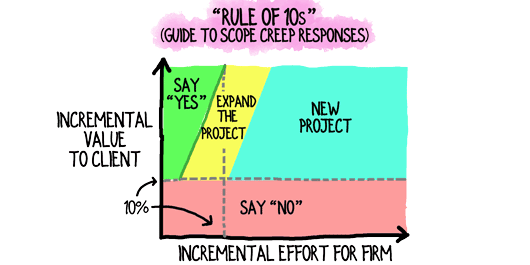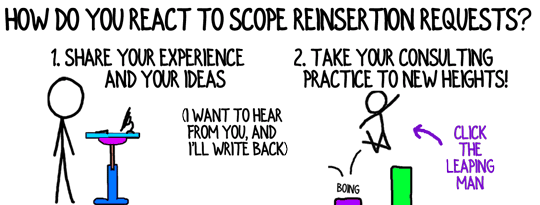Sometimes clients ask you to add scope to a project, for free, that they previously removed to reduce the project’s budget. Do you and your team know the best way to handle this situation?
About a month ago your consulting firm won an engagement with wetlands landscaping giant, Sodden Changes, Inc. (SCI). It wasn’t an easy project to win, though, and required multiple rounds of scope revisions with SCI’s CEO, Reverend (“Rev”) James Ursal.

For instance, Rev said SCI would lead the marsh audit, asking you to provide only supervisory guidance. That change reduced the total project fees $40K, down to $350K.
However, one month into the initiative, SCI’s other priorities have bogged down the marsh audit. During your project update call yesterday, Rev mentioned that the Board was deeply interested in the results of the audit and that internal perceptions of the project would improve if your consulting firm “lent a hand” to move the marsh audit along.
That stinks.
And, of course, Rev’s tone indicated he wasn’t expecting to pay for the extra help.
Double stinky.
Scope creep is particularly frustrating when clients explicitly remove tasks and work from your proposed scope to reduce the budget, then later ask you to take on those same tasks without a commensurate fee increase.
Your response to this situation is pretty obvious. Most consultants know what to do.
When you review the “Rule of 10s” you quickly ascertain that Rev’s requested increases in effort and value warrant a paid, project expansion.

What’s less obvious is the tone of your response. That’s where many consultants muck up their opportunity.
When Rev implies that you should wade deeper into the marsh audit for free, your reaction is, understandably, a mixture of incredulity, frustration and perhaps even defensiveness.
Many consultants would point out to Rev that he removed the marsh audit from the original scope to save $40K and that SCI’s internal challenges are causing any delays.
That’s not helpful.
Bury those negative emotions and cover them with a reaction that is supportive, enthusiastic and delighted with the opportunity.
You’ll arrive at the same recommendation—a project expansion, and with a higher likelihood of winning the additional engagement.
Also, you’ll have reinforced the impression that you’re cooperative; that your consulting firm is a collaborative partner rather than defensive, combative, difficult vendor.
Specifically, compliment Rev on his thinking, ignore the fact that he previously removed the same work from the project scope, and state matter-of-factly that his aspirations can become a reality for a small fee.
It sounds like this:
“Getting us more involved in the marsh audit is a great idea, Rev. As you said, your folks’ plates are full, and we are experienced at creating audit presentations that delight Boards. We can jump on that right away and the fee increase would be pretty modest. Do you want me to write up a quick proposal?”
If Rev pushes back on the additional fees, again resist your temptation to mention that he previously stripped the audit out of the scope to save money. That’s water under the bridge.
Stay positive, upbeat and firm in your position:
“It would be great if we could take over much of the audit for free, but that’s just not feasible. You’re right that this would be a smart investment for SCI if you can swing the small bump in total fees. Let me know how you want to move forward.”
By handling scope creep requests correctly, you maximize your likelihood to expand projects and win future engagements from your consulting firm’s clients.
Thoughts?
Text and images are © 2024 David A. Fields, all rights reserved.

 David A. Fields Consulting Group
David A. Fields Consulting Group 

Perfect! I’ve learned how effective this approach can be from you David and it has resulted in more revenue, less haggling and ultimately, happier clients. Give the client what they want upfront and if needed, add on incremental projects as needed for a fee!
Thanks as always for valuable advice and how to execute with ease!
You’re a superstar, Frank! Business development is definitely easier and more fun when we offer what our clients want rather than what we’re hoping to sell!
I appreciate your sharing your reaction, Frank.😊
I love the slight shift of the emotionality, instead of using the lens of frustration, you use the lens of helping with positivity to achieve a win-win.
Exactly right, Jessica. Our role as consultants is to always act as the adult in the room, or the team captain; To be the one that can see the opportunity for cooperation and collaboration while preserving fairness for all sides.
Thank you for highlighting that important aspect of the article, Jessica!
This is incredibly useful. I was not aware of the Rule of 10s, but I like it. My frustration is from monthly retainer work, where scope seems to creeps, just a bit but in different ways, every month. Wondering whether I should think of that 10% cumulatively or monthly? Granted, I’m sure this comes from being with this client for too long….
Great question, Erin. I think we may address this in an upcoming Monday 15-minute live session too. (https://davidafields.com/mondaylive)
Ideally, you price your engagements so that 10% scope creep is no big deal and you can give that extra effort to your client without any further thought or discussion. However, if the client is asking for additional scope beyond 10% then it’s time to have a conversation. If your contracts are structured such that your clients pay monthly and can cancel every month (in which case, you should consider restructuring your contracts), then you look for a trend. If the client always asks for extra work, then you say something along the lines of, “Thank you for giving me extra opportunities to provide value. You’re doing a great job of asking for support and using it. To be fair to both of us, going forward we’ll need to adjust the fee slightly to accommodate the extra work.”
I appreciate you creating the opportunity to dig deeper into the topic, Erin!
I encounter situations like this with some regularity with clients and have always found that approaching it with some “good energy” makes all the difference in the world!
On occasion, however, their additional requests sometimes come at the worst time, when the consulting team has their dance card completely full, and they don’t have the time to support the incremental work within the timeframe necessary…but it’s certainly a nice problem to have.
Great insights!
Good point, Mike. There are times when you can’t accommodate a client’s requests even if you and they want to. Those times should be rare, though. If we live in a world of “always find a way” in service of our clients, then 90% of situations that at first glance appear to be impossible turn out to be situations where we can make magic happen. Clients notice and appreciate that magic.
As you said, when clients ask for more it’s a good thing. When clients ask for less you know you’re in trouble!
Thanks for jumping into the conversation, Mike!
I, too, have never heard the rule of 10s. If the work involved is greater than 10% effort and less than 10% added value, I know how to say no to the client.
But if the effort is less than 10% (the bottom left box) I’m struggling with what to say.
I guess I could say “Yes that’s a great idea, but let’s keep the team focused on the original deliverables, and if we have time at the end of the project, we can decide together how to tackle it!”
What do you think?
Thanks for bringing up that question, Ken. You’re exactly right, if a client suggests work that is not value added, you ask something along the lines of, “Interesting idea. Do you think it’s worth pulling resources away from our current initiative to complete your new request, or is the original work still a higher priority?” In other words, let the client tell themselves that low-value work is a distraction not pursuing.
As an aside, the Rule of 10s is presented in this article.
Great addition to the discussion, Ken!